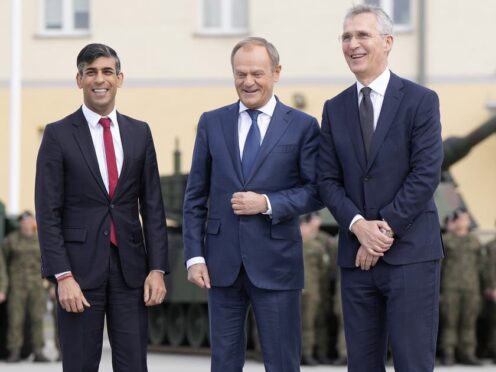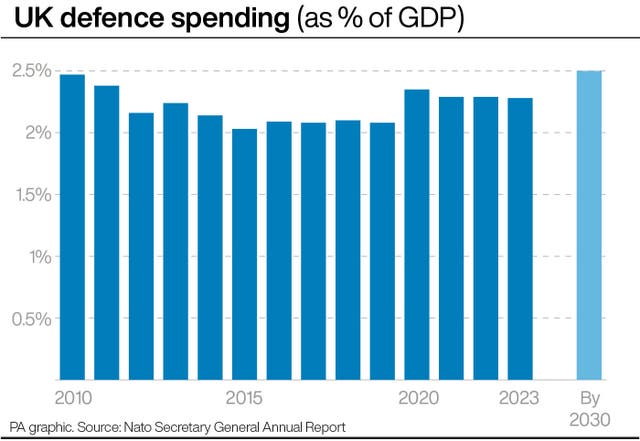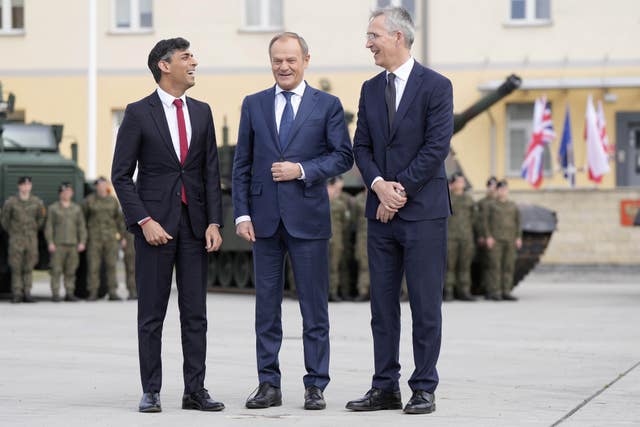
Rishi Sunak promised an extra £75 billion in defence spending over the next six years as he warned the world is “the most dangerous it has been” since the end of the Cold War.
The Prime Minister said the UK will spend 2.5% of gross domestic product (GDP) on defence by 2030.
This re-commits to a target set by Boris Johnson in 2022 and firms up Mr Sunak’s own stance on the defence budget.
The Prime Minister and Chancellor Jeremy Hunt had previously only said the 2.5% goal would be met when the economic conditions allow.
But committing to 2030 is unlikely to appease some on the Conservative benches who have been pushing for at least 3% to be spent on defence at a time when Vladimir Putin’s Russia is waging war on a European neighbour.
Mr Sunak set out the plan at a joint appearance with Nato Secretary-General Jens Stoltenberg at a military base in Warsaw, Poland.
Under the new spending plan, the UK defence budget will increase immediately and then rise steadily to reach £87 billion at the end the decade.

Mr Sunak told the press conference in a military hangar: “We did not choose this moment but it falls on us to meet it.
“In a world of increasing threats we must show our enemies that we are resolute and determined, that their attempts to destabilise our world and redraw its borders by force will fail.
“That with our friends and our allies, we will be at the forefront of the defence of the free, democratic world.
“Under my leadership, the UK will always stand up for our interests, deter our enemies and defend our values.”

He warned about the threats facing the world from “an axis of authoritarian states” including Russia, China, Iran and North Korea, which are not “far away problems” but “pose real risks to the United Kingdom’s security and prosperity”.
The UK’s latest defence commitments could be made as a result of “our management of the economy”, Mr Sunak suggested. He said the increase in defence spending, which would be fully funded with no increase in borrowing or debt, would put the UK “on a war footing”. Mr Sunak also promised a long-term funding guarantee for Ukraine.
The UK will provide “at least the current level of military support to Ukraine for every year it is needed”.
Mr Sunak intervened when Mr Stoltenberg was asked how reassured he could be by the UK’s announcement of increased defence spending when there could be a new government taking office later this year. It “wouldn’t be appropriate” to draw the Nato Secretary-General into domestic politics, the Prime Minister said.
Mr Hunt and Defence Secretary Grant Shapps travelled with Mr Sunak and backed the announcement.
The Chancellor said it “sends the clearest possible message to Putin that, as other Nato European countries match this commitment, which they will, he will never be able to outspend countries that believe in freedom and democracy”.
Drawing lessons from the war in Ukraine, the Government promised a further £10 billion over the next 10 years to ensure the military does not run out of ammunition and missiles.
This represents nearly a doubling of current UK spending on munitions production and will focus on capabilities including air defence missiles, anti-armour munitions and 155mm artillery shells.
I spoke with @RishiSunak, who informed me that the UK has allocated the largest defence support package for Ukraine to date, worth half a billion pounds.
Storm Shadow and other missiles, hundreds of armored vehicles and watercraft, ammunition—all of this is needed on the…
— Volodymyr Zelenskyy / Володимир Зеленський (@ZelenskyyUa) April 23, 2024
The announcement comes after Mr Sunak unveiled a £500 million military aid package including missiles, armoured vehicles and boats for Ukraine.
Ukrainian President Volodymyr Zelensky, who spoke to the Prime Minister on Tuesday morning, said “all of this is needed on the battlefield”.
Mr Sunak said Mr Zelensky is “in good spirits”, “very positive” about renewed US support and “very grateful” for UK help.
Mr Sunak also stressed the importance of Europeans investing in their own security and Nato countries reaching their 2% defence spending commitment.
He said the news that the US House of Representatives ended a months-long stalemate by approving a critical 61 billion US dollar (£49 billion) aid package for Ukraine was “very welcome”, but added “that doesn’t take away from the need for Europeans to invest in their security”.
Mr Sunak warned Russian President Mr Putin “will not stop at the Polish border” if his assault on Ukraine is allowed to succeed.

Mr Zelensky welcomed what he said is the “largest defence support package for Ukraine to date” from the UK.
“Storm Shadow and other missiles, hundreds of armoured vehicles and watercraft, ammunition – all of this is needed on the battlefield,” he said.
“I am grateful to the UK and personally to Prime Minister Sunak for such a strong demonstration of support and for the willingness to further develop our defence co-operation, especially with an emphasis on maritime and long-range capabilities.”
The promised equipment includes around 400 vehicles, more than 1,600 strike and air defence missiles, 60 boats and nearly four million rounds of small arms ammunition.

Enjoy the convenience of having The Sunday Post delivered as a digital ePaper straight to your smartphone, tablet or computer.
Subscribe for only £5.49 a month and enjoy all the benefits of the printed paper as a digital replica.
Subscribe